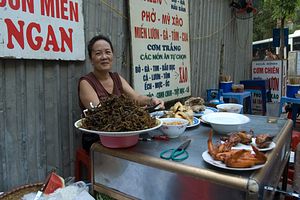Vietnamese eat diets are changing, there is little doubt about that. People eat more than before, and they eat much more meat and animal products.
This is hardly surprising, given that the country over the past three decades has transformed from one of Asia’s poorest countries to an “emerging economy” and in the process gone from food shortage to food abundance. But even if taking into account that increasing meat consumption is expected alongside economic growth, increasing affluence, and urbanization, the changes seen in Vietnam have been remarkable.
Vietnam is indeed home to a dramatic transformation toward more meat-intensive eating habits. Not that long ago, common Vietnamese diets consisted mainly of rice and vegetables. Meat was eaten only on special occasions. Now, it is quite common to include meat in every meal of the day. Indeed, the average Vietnamese person eats four times more meat now than she did 30 years ago.
Farming, Pho and Fast Food
We need to look at the whole chain from production to consumption in order to understand what is going on.
To start at the farm, Vietnam’s dramatic increases in agricultural output since the 1986 doi moi economic reforms are well-known. But while coffee and rice have attracted much attention, meat has largely gone under the radar. Vietnam has seen spectacular increases in output in the livestock sector. Indeed, production in the livestock sector has grown faster than production in crops, and now represents one-third of all agricultural output in the country.
Furthermore, much of the meat consumed in Vietnam comes from farmers in other parts of the world, and increasingly so. Alongside new trade agreements, imports of meat from different parts of the world, especially the United States and India, have soared, mostly for chicken and beef. Vietnam is now even importing live cattle from Australia for domestic slaughter.
To continue along the value chain, slaughterhouses are now larger and more efficient. The access to meat has also increased at the retail side, with a large increase in supermarkets and mini-marts, as well as street kitchens, fast food joints, and restaurants.
But none of this matters, of course, unless people actually want to eat more meat.
A Growing Meat Culture
Meat has become an increasingly important part of Vietnamese consumers’ food practices, although in many different ways. Some practices are quite conspicuous, like the boom in high-end steak houses where rich Vietnamese easily spend a worker’s monthly salary on a meal of imported steak while sipping imported red wine. Other are inconspicuous, like the gradual increase of amounts of meat in street food. Take the famous pho as an example: not that long ago it would come with tiny servings of beef (or chicken), if any at all. Now some consumers are complaining that there’s too much meat in the soup. Changing eating habits are also obvious from the fact that while pork remains the by far most popular form of meat, consumption of beef and poultry is increasing at a faster pace.
Steakhouses and pho takes us toward an important part of the meat intensification of Vietnamese diets. Studies show that across countries and cultures, people tend to eat more meat when eating out than when eating at home. In Vietnam, the typical family meal now includes meat, but often only as a small part of an overall meal consisting of rice, vegetables, and sometimes seafood. Over the last decades, however, Vietnamese have been going out to eat much more than before.
Fast food chains like McDonalds and Burger King are part of this new food scene. However, “Eastern” influences are arguably much stronger than “Western.” For example, Japanese and Korean-style BBQ joints are extremely popular, and highly meat intensive.
Meat as Progress
While all of this is going on, however, many Vietnamese are cutting back on meat consumption, usually for health reasons, but a few also for environmental or animal rights concerns. Going vegetarian is indeed trendy among the young, urban middle classes, often to the amazement and disdain of parents and grandparents who remember a time when meat was a luxury.
And this is a crucial point. In a country where even the richest parts of the population clearly remember extreme scarcity, meat is for many a defining part of progress. Thus, while wealthy Vietnamese may be cutting back on meat, many have just recently been able to afford it. Indeed, many of the processes I have outlined as driving forces behind the meat boom are at early stages in the country. Alongside increasing vegetarianism, it is thus highly likely that we will see a further increase in meat consumption in Vietnam.
Arve Hansen is Postdoctoral Fellow at Center for Development and the Environment, University of Oslo.

































